50+ Time Logs
-

Service-Learning Time Log
download now -

Internship for Credit Time Log
download now -

Clinical Experience Time Log
download now -

Daily Time Log
download now -

Independent Participant Time Log
download now -

Student Weekly Time Log
download now -

Practicum Time Log
download now -

Sample Daily Time Log
download now -

Internship Time Log
download now -
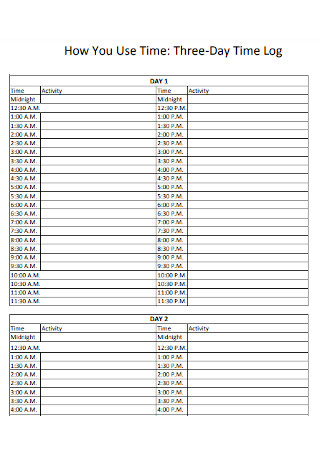
Three-Day Time Log
download now -

24 Hours Time Log
download now -

Time Log and Receipt
download now -

Time Log Sheet
download now -

Daily Time Management Log
download now -

Weekly Time Log
download now -
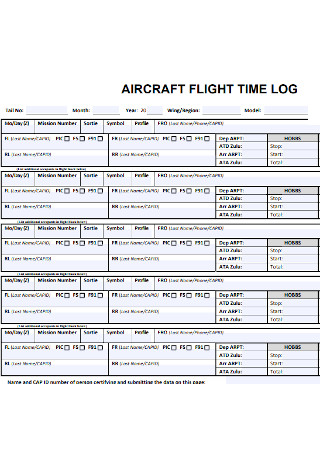
Flight Time Log
download now -

Accountability Time Log
download now -

Time Log of Practicum Hours
download now -

Student Time Log
download now -

Simple Time Log Template
download now -

Time Temperature Log
download now -

Sample Internship Time Log
download now -

Physical Education Time Log
download now -

Part-Time Professional Monthly Time Log
download now -
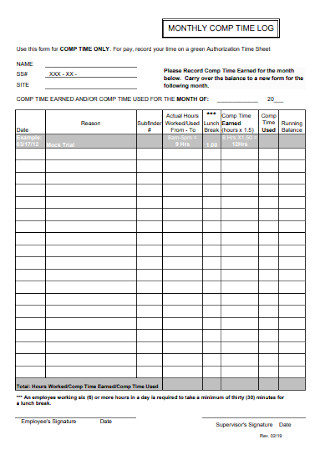
Monthly Comp Time Log
download now -

Silver Award Project Time Log
download now -

Bronze Award Time Log
download now -

Trail Ranger Time Log
download now -

Sample Service Learning Time Log
download now -

Education Internship Time Log
download now -

Club Volunteer Time Log
download now -

Practicum Time Log Template
download now -

Silver Award Time Log
download now -

Student Pro Bono Time Log
download now -

Time Log Format
download now -

Patient Time Log Report
download now -

Screen Time Log Template
download now -

Project Time Log
download now -

Volunteer Time Log
download now -

Pilot Study Time Log
download now -

Externship Time Log
download now -
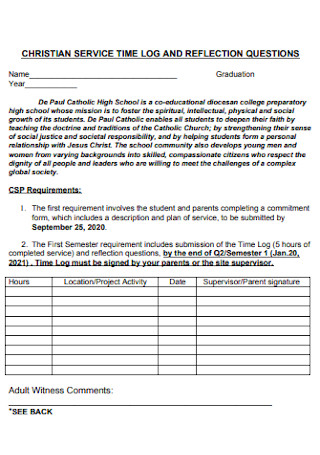
Christian Service Time Log
download now -
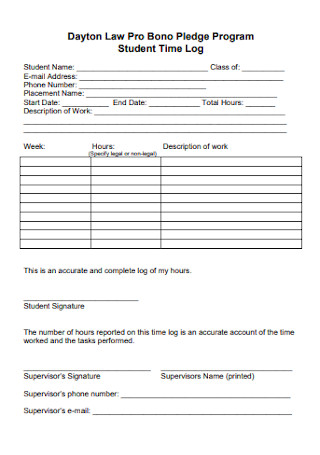
Program Student Time Log
download now -

Recreational Riding Time Log
download now -

Trainee Bridge Inspector Time Log
download now -

Student Manager Monthly Time Log
download now -

Standard Time Log
download now -

Residency Time Log
download now -

Drive Time Log Sheet
download now -

Web Time Entry Time Log
download now -

Productive Choice Time Log
download now
There is also no way to stop time. It continues to persist and stops for no one. Time remains to be a relevant factor not only in our personal lives but also influences work life. All staff within an organization follows defined guidelines at work, including the required time to log in and log out of their job. A time log helps keep track of these times to inform the management of this period. Read through the article below to learn about a time log, including its definition, composition, and creation, with frequently asked questions about the document.
What Is a Time Log?
A time log is a set of written reports chronologically recorded to track and detail employee activities with a time stamp. These tracking records of an employee’s time are for analysis, work optimization, and employee compensation. Time logs are recorded electronically through an online time log or application or manually using a time card or timesheet. The human resources team then keeps the documents for employee evaluation and record keeping. The management has an accurate understanding of the log, eliminates low-value activities, and invests meaningful time on activities contributing to the organization’s growth and success. Small business owners and freelancers use these time logs to track billable hours, time spent on projects and assess time management by groups and individuals in a specific team.
According to the news release by the Bureau of Labor Statistics released on June 25, 2020, on average, those who worked at their respective workplace worked for 7.9 hours, while those who worked from home averaged 3.3 hours daily in 2019. The data of daily work hours shows a notable difference between individuals on-site working longer periods compared to those working at home.
Essential Parts of a Time Log
A time log, usually in the form of a timesheet or time card, is used to obtain timely and accurate information that captures all necessary information of employees without complex processes. Most employees do not take time logs seriously despite their use. It is essential to emphasize the importance of keeping these logs to ensure employees complete them daily. Below are the significant parts of a time log.
How to Effectively Use a Time Log
Daily activity isn’t always constant, even for organizations needing to meet work quotas or produce a certain amount of deliverables. Using a time log can help meet deadlines and even make an individual more productive in a workday or week. It helps to use a time log, especially for professions requiring to harness creativity and productivity regularly. Here are some helpful steps in using a time log.
Step 1: Write Down What an Ideal Day Looks Like
In writing daily activities, make sure accurate information is present. Include the hours, activities, mood or feelings, and more relevant details. The tip here is not to write what looks to be a typical day at work, do not put the things already being done. Instead, think about what signifies a perfect daily schedule catering to your preference and lifestyle, including hobbies, relationships, and other activities that the individual wishes to accomplish. There are no right or wrong answers in creating a schedule based on your preference.
Step 2: Create a Detailed Time Log for More Than a Day
As the first step, after completing the journal of a perfect day, keep a log lasting for three days more. Similar to the first entry, include a detailed description of the hours, activities, moods, and other related information that makes a day ideal. Do not fuss if the entry diverges away from a perfect depiction of a day. The individual must be honest and sincere to a fault about what constitutes to be an impeccable day, whether it is a workday or a regular day. The goal in doing this step is to get a realistic depiction of how the individual plans to spend their day to take control in performing what is on schedule.
Step 3: Utilize a Comparison With a Time Log
After the individual has kept track of three days worth of their work activities in a time log, line up the results with the journal entries. Take note of any differences or similarities between the actual schedule and the ideal schedule for accomplishing activities. Individuals appear to be surprised by the sheer amount of wasted time in a day. Activities like browsing through social media pages, watching a quick tutorial, or listening to a new music album by their favorite artist can contribute to time wastage without the individual’s knowledge. It is necessary to ask what changes must a person make to turn their ideas into their lifestyle and reality. For others, it is through tiny changes in their routine. For some, it is a complete 360-degree change. The alternatives are viable for as long as the individual learns for themselves that change is necessary.
Step 4: Design a Realistic Schedule With Consideration of Ideals and Needs
In analyzing the idealized schedule, keep in mind the significance of each item or activity on the list. In truth, an individual cannot change everything in a single day, and it’s best to prioritize the crucial aspects the individual envisions. Perhaps cut off some time from streaming your favorite show or drama, and focus on completing at least one of the daily tasks. It helps to be very accurate to the length of recording bedtime and waking hours in the new journal entry. It is also necessary to budget time for family, friends, and personal time. It is also beneficial to break various activities into categories, making them easier to do.
Step 5: Set Alarms to Aid in the Shift of Activity
Generally speaking, habits are hard to break. Shifting from one habitual activity to another that is more beneficial than the previous one is a difficult change. It helps to have external feedback and methods to help develop into the new routines. One way to do this is to set alarms, either on a phone or the computer, that helps remind an individual to switch between activities and adhere to them. Taking control of personal workflow does not only help improve an individual’s work-life balance and mental health, but it also increases the productivity and quality rate of outputs and services. It also leaves room for building the client list or a possible work promotion.
FAQs
What are the benefits of tracking activities through a time log?
There are plenty of benefits relating to tracking activities in a time log. For one, it improves an individual’s productivity and sustains positive working habits. Understanding how a person allocates time in certain activities brings a sense of realization and reveals how much time an individual is at a loss. In using a time log, a person quickly identifies where they are lagging in activities. Through this, a person finds a way to manage their time efficiently in a more sustainable manner. It is most advantageous to people who seem to have no time left in their overloaded and disorganized days. A time log also aids in increasing progress in life and work. People get easily distracted when they feel like work is becoming more of a pressure and only see its impact when it is in front of them. In using a time log, there is a clear distinction between a professional and personal tasks list. By having this knowledge, a person makes necessary adjustments to accommodate time spent on essential activities. A time log also gives a sense of responsibility. Knowing time spent on performing actual daily tasks is a valuable reminder of taking accountability. It helps record things accomplished and helps stay focused on remaining tasks. Some people also use time logs to monitor their performance and avoid distractions that affect daily productivity. It also brings about motivation to improve performance by comparing past and current activities to challenge the individual to perform better daily. It helps an individual to understand their capabilities. Individuals without the concept of time cannot set realistic expectations. Tracking and recording allow a person to see the exact number of hours to finish a task when focused and motivated. It also makes it easier to devise routines according to capabilities.
What do you need to do more of in the day?
Spending too much time on specific tasks results in less time to do other activities. It is essential to look over the time spent in the day and gauge what an individual can do by cutting downtime on some tasks or completely removing irrelevant ones. It helps to give an estimated picture of the time left after readjustment. After, the individual can incorporate some activities relevant or beneficial to them but have no time to do before the adjustment. It is advantageous to include these into the daily routine and record how much needed time is exhausted to gauge if the process is suitable for the person’s schedule efficiently.
Are there realistic timeframes to accomplish all tasks?
Always remember that the only way to be productive is to set have SMART goals with realistic expectations. Some tasks appear to be easily attainable, but once an individual starts focusing on them, adjustments and realizations occur. It is necessary to set goals that are specific, measurable, achievable, realistic and time-bound. Before cutting some time on tasks, base the decision on past performance and experience. There is a high chance that the time log shows an accurate depiction of the precise time to fulfill the activity if the individual knows that they channeled all their focus to accomplish assigned tasks and optimized them to the best of their ability. Just a quick and relevant takeaway, fit all assignments into the schedule and focus on creating a productive and desirable routine each day.
Keeping a time log benefits the employee more than the employer or the management. Aside from both tracking productivity and performance, it also allows employees to be more time-conscious, realistic, and have positive working habits. It proves to be a difficult task to get away from practice, but keeping a time log and taking the appropriate steps to ensure the growth of an individual is already an improvement. What matters is that the individual can correctly manage their time and stick to a better routine from comparing past performance with current ones. In the words of Alexis Carrel, “The most efficient way to live reasonably is every morning to make a plan of one’s day and every night to examine the results obtained.” It is not enough to plan unless a person follows through with it as well. The time log samples in the article are available for use and download, so start managing time well and build better working habits.
